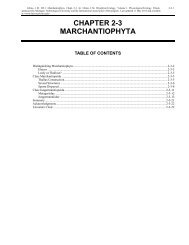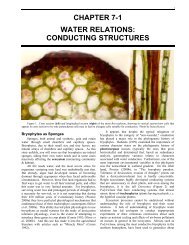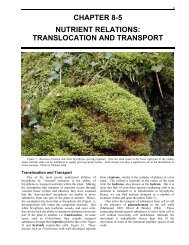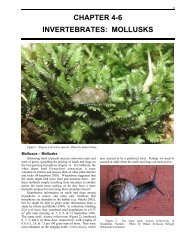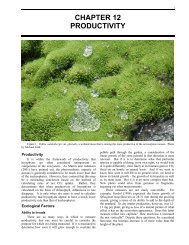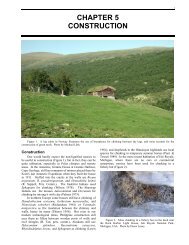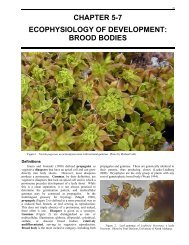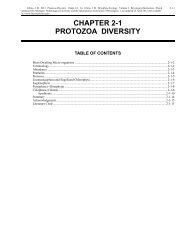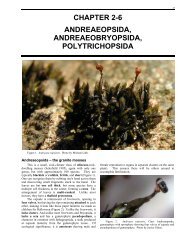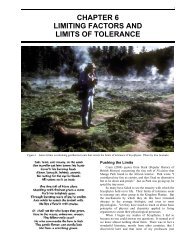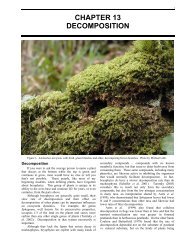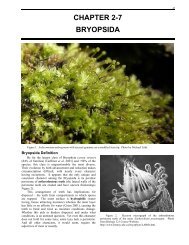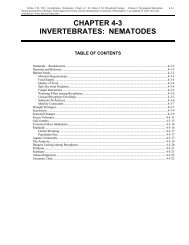Chapter 4-5 Invertebrates Rotifers - Bryophyte Ecology - Michigan ...
Chapter 4-5 Invertebrates Rotifers - Bryophyte Ecology - Michigan ...
Chapter 4-5 Invertebrates Rotifers - Bryophyte Ecology - Michigan ...
You also want an ePaper? Increase the reach of your titles
YUMPU automatically turns print PDFs into web optimized ePapers that Google loves.
4-5-8 <strong>Chapter</strong> 4-5: <strong>Invertebrates</strong>: <strong>Rotifers</strong>temperature and desiccation and do not need food.Frequent reproduction could be detrimental to theseanimals if they do not have sufficient resources to sustainthem during the anhydrobiotic state. Success is furthersupported by a delay in maturity that reduces reproductivecost. On the other hand, in the water, large adults may beeasy prey, favoring a shorter time to maturity.The temperature relationships of the moss-dwellingrotifers are interesting. Compared to the non-mosspopulations, those of Macrotrachela quadricorniferaliving among mosses exhibit an irregular response toincreasing temperature in the range of 16-24°C (Ricci1991). Furthermore, the aquatic (non-moss) strainsinvested maximum resources in reproduction (r strategists),consequently reducing their survival, whereas the mossdwellingstrains were long-lived and invested fewerresources in their reproduction (K strategists). Ricci pointsout that the moss habitat experiences a much greatertemperature fluctuation in a shorter period of time thanwould occur in the aquatic non-moss habitats. Riccisuggests that the terrestrial moss habitat has much moreimportant limiting factors – availability of food andmoisture, whereas a wide temperature range with suddenchanges must be tolerated.The moss-dwelling rotifer strains differ slightly insize, with moss-dwellers being smaller than the aquaticstrains. Among the Macrotrachela quadricornifera, eggsand juveniles are less able to recover from desiccation thanare mature animals. This species is a good bet-hedger,encompassing multiple strategies for survival in a varietyof habitats. The moss habitat undoubtedly offers theadvantage of slow drying, which increases survivorshipupon rewetting (Ricci et al. 2003a).Macrotrachela quadricornifera, a bdelloid rotifer, isa filter feeder whose food preference and survivorship alsodiffered among the habitat strains (Ricci 1991). Mossdwellers were unable to survive on yeast (Saccharomycescerevisiae) alone, whereas the two aquatic strains survivedand grew. One of the moss-dwelling strains was unable toeat Chlorella pyrenoidosa. The other moss strain did beston Escherichia coli, which resulted in poor growth of allthe other strains. It appears that the habitat may influencethe types of enzymes available for digestion of food. Wecannot, however, say if this is an environmental responseduring development or a genetic one that has persistedthrough a number of moss-dwelling generations.On the other hand, the moss-dwelling Macrotrachelaquadricornifera suffers a much shorter desiccation survivalperiod (Ricci et al. 1987). In experiments, five-day-oldstressed rotifers had significantly decreased fertility,whereas 14-day-old stressed individuals had decreased lifespans. Age also affected ability to survive drying. Thehighest recovery rate occurred for 8-day-old rotifersstressed for 4 days, whereas no rotifers aged 5 dayssurvived 30 days of drying. Macrotrachelaquadricornifera shrinks considerably in size duringdehydration, with the anhydrobiotic animal having onlyabout 60% of the volume of the hydrated form (Ricci et al.2008; see also Marotta et al. 2010). The internalorganization changes drastically, with body cavitiesbecoming indistinguishable. Even more extreme is its lossof more than 95% of its weight when anhydrobiotic, mostlyas water. This water loss is inconsistent with a 60%volume loss and Ricci and coworkers suggest that it mayindicate presence of space-filling molecular species in thedehydrated animal.One reason for the abundance of bdelloid rotifers onbryophytes is that they share with the bryophytes thisability to enter the state of cryptobiosis (anhydrobiosis)(Wallace & Snell 1991; Fontaneto & Ricci 2004). Guidetti& Jönsson (2002) examined rotifers that had been kept dryfor 9-138 years. The adult stage may have a limitedcryptobiotic lifespan in the presence of oxygen, but therotifer Mniobia (Figure 19) survived live as eggs for nineyears on bryophytes, suggesting that the egg stage (Figure20) might have greater longevity than the cryptobiotic adultstage. This appears to be the longest record for rotifersurvival in anhydrobiosis other than the 59 years for anadult reported by Rahm (1923) from a herbarium moss.Figure 19. Mniobia sp. with egg. Photo by Walter Dioni.Figure 20. Egg stage of a rotifer on algae. Photo by MichelVerolet.Ability to contract and fold seems important to thesurvival of Macrotrachela quadricornifera (Ricci et al.2004). Upon drying, the rotifer contracts, drawing its footand head into the body trunk (Ricci & Melone 1984).Starved rotifers of this species survive better than those fedon concentrated food, with food remaining in the gut whenthe latter form the tun (Figure 21) (Ricci et al. 2004). It ispossible that the reason for the reduced survivorship is thatthe food interferes with the necessary folding andcontraction.These data for Macrotrachela quadricornifera raisethe question of how these animals survive on bryophytes.For these experiments, the mosses were collected from aspring-fed pond in Italy (Ricci et al. 1987). Hence, it islikely that the humidity remained higher than that of the



